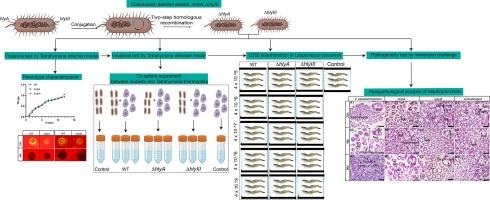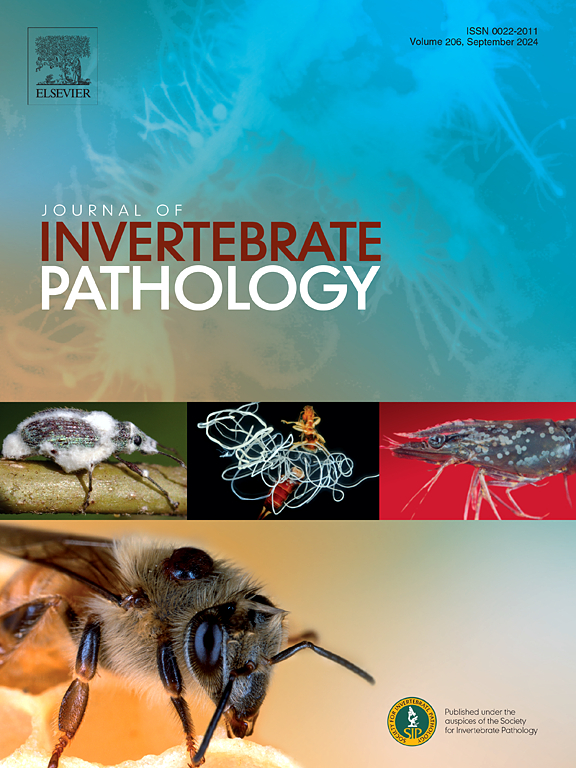副溶血性弧菌中不同溶血素基因缺失菌株(ΔhlyA、ΔhlyIII)的构建和特征描述及其毒力评估。
IF 3.6
3区 生物学
Q1 ZOOLOGY
引用次数: 0
摘要
副溶血性弧菌是一种嗜卤食源性病原体,具有多种致病因子。副溶血性弧菌的致病性是多种致病因子综合作用的结果。据推测,除了tdh 和 trh 外,副溶血性弧菌的 HlyA 和 hlyIII 基因还具有溶血功能。为了证实 hlyA 和 hlyIII 基因的溶血功能,通过同源重组分别构建了副溶血弧菌的 ΔhlyA 和 ΔhlyIII 菌株。利用四膜虫-弧菌共培养模型和万年青浸泡法评估了 ΔhlyA 和 ΔhlyIII 菌株的细胞毒性和致病性。结果表明,与 WT 菌株相比,ΔhlyA 和 ΔhlyIII 菌株的溶血活性分别降低了约 31.4% 和 24.9%。ΔhlyA和ΔhlyIII对四膜虫的细胞毒性都有所降低。虾感染实验显示,ΔhlyA 和 ΔhlyIII 的半数致死剂量分别为 3.06 × 108 CFU/mL 和 1.23 × 108 CFU/mL,均高于 WT 菌株的 2.57 × 107 CFU/mL。组织病理学观察显示,受到 ΔhlyA 和 ΔhlyIII 挑战的对虾的肝胰腺表现出轻微症状,而受到 WT 菌株挑战的对虾则表现出严重的 AHPND。这些发现表明,ΔhlyA 和 ΔhlyIII 株系的毒力明显低于 WT 株系。总之,hlyA 和 hlyIII 都是参与副溶血性弧菌溶血和细胞毒性的重要毒力基因。本文章由计算机程序翻译,如有差异,请以英文原文为准。

Construction and characterization of different hemolysin gene deletion strains in Vibrio parahaemolyticus (ΔhlyA, ΔhlyIII) and evaluation of their virulence
Vibrio parahaemolyticus, a halophilic food-borne pathogen, possesses an arsenal of virulence factors. The pathogenicity of V. parahaemolyticus results from a combination of various virulence factors. HlyA and hlyIII genes are presumed to function in hemolysis, in addition to tdh and trh in V. parahaemolyticus. To confirm the hemolytic function of genes hlyA and hlyIII, ΔhlyA and ΔhlyIII strains of V. parahaemolyticus were separately constructed via homologous recombination. The cytotoxicity and pathogenicity of the ΔhlyA and ΔhlyIII strains were evaluated using a Tetrahymena-Vibrio co-culture model and an immersion challenge in Litopenaeus vannamei. Results indicated that the hemolytic activity of the ΔhlyA and ΔhlyIII strains decreased by approximately 31.4 % and 24.9 % respectively, compared to the WT strain. Both ΔhlyA and ΔhlyIII exhibited reduced cytotoxicity towards Tetrahymena. Then shrimp infection experiments showed LD50 values for ΔhlyA and ΔhlyIII of 3.06 × 108 CFU/mL and 1.23 × 108 CFU/mL, respectively, both higher than the WT strain’s value of 2.57 × 107 CFU/mL. Histopathological observations revealed that hepatopancreas from shrimps challenged with ΔhlyA and ΔhlyIII exhibited mild symptoms, whereas those challenged with the WT strain displayed severe AHPND. These findings indicate that the ΔhlyA and ΔhlyIII strains are significantly less virulent than the WT strain. In conclusion, both hlyA and hlyIII are vital virulence genes involved in hemolytic and cytotoxic of V. parahaemolyticus.
求助全文
通过发布文献求助,成功后即可免费获取论文全文。
去求助
来源期刊
CiteScore
6.10
自引率
5.90%
发文量
94
审稿时长
1 months
期刊介绍:
The Journal of Invertebrate Pathology presents original research articles and notes on the induction and pathogenesis of diseases of invertebrates, including the suppression of diseases in beneficial species, and the use of diseases in controlling undesirable species. In addition, the journal publishes the results of physiological, morphological, genetic, immunological and ecological studies as related to the etiologic agents of diseases of invertebrates.
The Journal of Invertebrate Pathology is the adopted journal of the Society for Invertebrate Pathology, and is available to SIP members at a special reduced price.

 求助内容:
求助内容: 应助结果提醒方式:
应助结果提醒方式:


